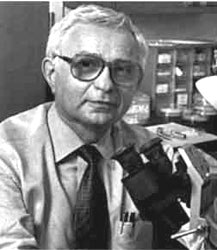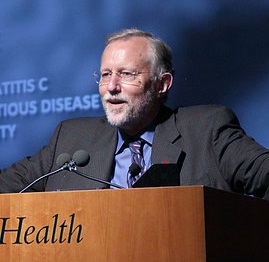Related Research Articles

Adeno-associated viruses (AAV) are small viruses that infect humans and some other primate species. They belong to the genus Dependoparvovirus, which in turn belongs to the family Parvoviridae. They are small replication-defective, nonenveloped viruses and have linear single-stranded DNA (ssDNA) genome of approximately 4.8 kilobases (kb).

Viral vectors are tools commonly used by molecular biologists to deliver genetic material into cells. This process can be performed inside a living organism or in cell culture. Viruses have evolved specialized molecular mechanisms to efficiently transport their genomes inside the cells they infect. Delivery of genes or other genetic material by a vector is termed transduction and the infected cells are described as transduced. Molecular biologists first harnessed this machinery in the 1970s. Paul Berg used a modified SV40 virus containing DNA from the bacteriophage λ to infect monkey kidney cell maintained in culture.
A helper dependent virus, also termed a gutless virus, is a synthetic viral vector dependent on the assistance of a helper virus in order to replicate, and can be used for purposes such as gene therapy. Naturally-occurring satellite viruses are also helper virus dependent, and can sometimes be modified to become viral vectors.
Allan McCulloch Campbell was an American microbiologist and geneticist and the Barbara Kimball Browning Professor Emeritus in the Department of Biology at Stanford University. His pioneering work on Lambda phage helped to advance molecular biology in the late 20th century. An important collaborator and member of his laboratory at Stanford University was biochemist Alice del Campillo Campbell, his wife.
Lynn William Enquist is professor emeritus in molecular biology at Princeton University, as well as founding editor of the journal Annual Review of Virology. His research focuses on neuroinvasive alpha-herpesviruses.

Bernard Roizman is an American scientist born in Romania. He is the Joseph Regenstein Distinguished Service Professor of Virology in the Departments of Microbiology and Molecular Genetics and Cell Biology at the University of Chicago.
Alice S. Huang (simplified Chinese: 黄诗厚; traditional Chinese: 黃詩厚; pinyin: Huáng Shīhòu; Wade–Giles: Huang Shih-hou; is an American biologist specialized in microbiology and virology. She served as President of AAAS during the 2010–2011 term.
Self-complementary adeno-associated virus (scAAV) is a viral vector engineered from the naturally occurring adeno-associated virus (AAV) to be used as a tool for gene therapy. Use of recombinant AAV (rAAV) has been successful in clinical trials addressing a variety of diseases. This lab-made progeny of rAAV is termed "self-complementary" because the coding region has been designed to form an intra-molecular double-stranded DNA template. A rate-limiting step for the standard AAV genome involves the second-strand synthesis since the typical AAV genome is a single-stranded DNA template. However, this is not the case for scAAV genomes. Upon infection, rather than waiting for cell mediated synthesis of the second strand, the two complementary halves of scAAV will associate to form one double stranded DNA (dsDNA) unit that is ready for immediate replication and transcription. The caveat of this construct is that instead of the full coding capacity found in rAAV (4.7–6kb) scAAV can only hold about half of that amount (≈2.4kb).
Adeno-associated virus integration site 1 is a viral integration site that in humans is encoded by the AAVS1 gene located on chromosome 19.
James M. Wilson is a biomedical researcher with expertise in gene therapy. Wilson graduated from Albion College and the University of Michigan . He completed residency training in Internal Medicine at the Massachusetts General Hospital followed by a postdoctoral fellowship at the Whitehead Institute.
Bernard Moss is a virologist at the National Institute of Allergy and Infectious Diseases, part of the United States National Institutes of Health. He is the Chief of the NIAID Laboratory of Viral Diseases and of the NIAID Genetic Engineering Section. He is known for his work on poxviruses.
Saswati Chatterjee is a virologist working as a professor at the Los Angeles City of Hope National Medical Center in the research department. Some of the viral areas she researches are: stem cells, gene therapy, genome editing, and parvovirus. Her main and current area of research is using Adeno-Associated Virus Vectors (AAV-Vectors). Additionally, she has had a role in many publications.

Charles Moen Rice is an American virologist and Nobel Prize laureate whose main area of research is the hepatitis C virus. He is a professor of virology at the Rockefeller University in New York City and an adjunct professor at Cornell University and Washington University School of Medicine. At the time of the award he was a faculty at Rockefeller.
Adeno-associated virus (AAV) has been researched as a viral vector in gene therapy for cancer treatment as an Oncolytic Virus. Currently there are not any FDA approved AAV cancer treatments, as the first FDA approved AAV treatment was approved December 2017. However, there are many Oncolytic AAV applications that are in development and have been researched.
Richard Jude Samulski is an American scientist, inventor, and academic recognized for his pioneering work in gene therapy and adeno-associated virus vectors (AAV) in the fields of molecular virology and pharmacology.

Karla Kirkegaard is the Violetta L. Horton Research Professor of genetics at the Stanford University School of Medicine. She was the chair of the Department of Microbiology and Immunology from 2006 to 2010. She is an elected member of the American Academy of Arts and Sciences and the National Academy of Sciences. Her research focuses on virology.
Mavis Agbandje-McKenna was a Nigerian-born British medical biophysicist, structural virologist, and a professor of structural biology, as well as the director of the Center for Structural Biology at the University of Florida in Gainesville, Florida. Agbandje-McKenna studied parvovirus structures using X-ray crystallography and cryogenic electron microscopy and did much of the initial work to elucidate the basic structure and function of adeno-associated viruses (AAVs). Her viral characterization and elucidation of antibody binding sites on AAV capsids has led to the development of viral capsid development and gene therapy approaches that evade immune detection and can be used to treat human diseases such as muscular dystrophies. Agbandje-McKenna was recognized with the 2020 American Society of Gene and Cell Therapy Outstanding Achievement Award for her contributions to the field. She died in 2021 from amyotrophic lateral sclerosis.
Max Duane Summers is an American molecular biologist and inventor, known for his work on the Baculovirus Expression Vector System (BEVS).
Edwin Herman Lennette was an American physician, virologist, and pioneer of diagnostic virology.
Dennis John O'Callaghan is an American virologist, immunologist, and biochemist. He is an internationally recognized expert on the molecular biology of the equine herpesviruses.
References
- ↑ "Berns, Kenneth". mgm.ufl.edu.
- ↑ Kotin RM, Siniscalco M, Samulski RJ, Zhu XD, Hunter L, Laughlin CA; et al. (1990). "Site-specific integration by adeno-associated virus". Proc Natl Acad Sci U S A. 87 (6): 2211–5. Bibcode:1990PNAS...87.2211K. doi: 10.1073/pnas.87.6.2211 . PMC 53656 . PMID 2156265.
{{cite journal}}: CS1 maint: multiple names: authors list (link) - ↑ "Kenneth Berns". www.nasonline.org.
- ↑ "Presidents of The American Society for Virology". American Society for Virology.
- ↑ "Historic Fellows". American Association for the Advancement of Science.